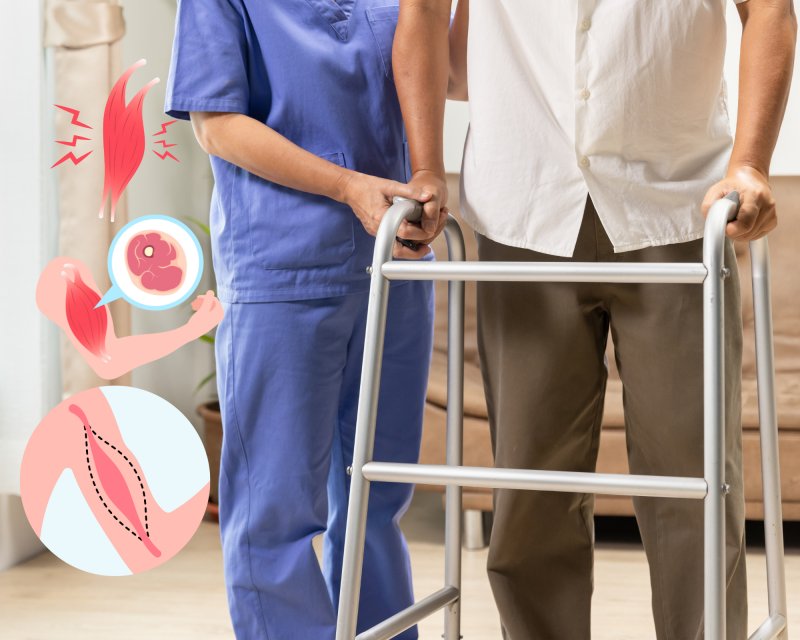Aging is inevitable, but losing your strength doesn’t have to be. One of the most underestimated health challenges of growing older is sarcopenia—a progressive loss of muscle mass, strength, and function that sneaks up as we age. Unlike wrinkles or grey hair, sarcopenia impacts how we live, move, and even how long we live.
But here’s the good news: sarcopenia is not only preventable—it can be reversed. In this blog, we’ll explore what sarcopenia is, why it matters, and how you can fight back with science-backed strategies.

Aging is inevitable, but losing your strength doesn’t have to be. One of the most underestimated health challenges of growing older is sarcopenia—a progressive loss of muscle mass, strength, and function that sneaks up as we age. Unlike wrinkles or grey hair, sarcopenia impacts how we live, move, and even how long we live.
But here’s the good news: sarcopenia is not only preventable—it can be reversed. In this blog, we’ll explore what sarcopenia is, why it matters, and how you can fight back with science-backed strategies.
🧠 1. What Causes Sarcopenia? (The Science Behind the Loss)
Sarcopenia doesn’t just happen because we get older. It results from a combination of biological, lifestyle, and environmental factors:
-
Decreased muscle protein synthesis: As we age, the body’s ability to build muscle declines, especially without the right nutrition and activity.
-
Hormonal changes: Lower levels of testosterone, estrogen, growth hormone, and IGF-1 all contribute to muscle loss.
-
Inflammation and oxidative stress: Chronic inflammation damages muscle cells over time.
-
Mitochondrial dysfunction: Aging muscles lose energy efficiency, making repair and growth harder.
🍽️ 2. Nutrition: Feed Your Muscles Right
What you eat plays a major role in muscle preservation.
-
Protein is king: Aim for 1.2–1.5 grams per kilogram of body weight per day, with a focus on leucine-rich sources like eggs, dairy, soy, and lean meats.
-
Vitamin D: Vital for muscle function and coordination—consider supplements if levels are low.
-
Creatine & HMB: These supplements have shown promise in supporting muscle strength in older adults.
-
Anti-inflammatory foods: Include berries, leafy greens, and omega-3-rich fish to reduce chronic inflammation that speeds up muscle loss.
🏋️ 3. Exercise: The Most Powerful Anti-Aging “Drug”
If there’s one proven way to reverse sarcopenia, it’s resistance training.
-
Strength training (with weights, resistance bands, or body weight) helps stimulate muscle growth and improve coordination.
-
High-intensity interval training (HIIT) can boost cardiovascular fitness and build muscle at the same time.
-
Balance and mobility exercises (like Tai Chi or yoga) reduce the risk of falls while improving core strength.
-
Even short daily walks can contribute to preserving leg muscle and endurance.
🧬 4. Genetics & Biomarkers: Your Muscle Blueprint
Some people are genetically more prone to sarcopenia, but genes are not destiny.
-
Researchers are exploring biomarkers like myostatin (which inhibits muscle growth) and IL-6 (a marker of inflammation) to detect sarcopenia earlier.
-
Personalized interventions based on your DNA and blood markers could soon become the norm in managing muscle loss.
💊 5. Medications & Experimental Therapies
While lifestyle is the cornerstone, new therapies are emerging:
-
Selective Androgen Receptor Modulators (SARMs) may help increase muscle mass with fewer side effects than steroids.
-
Myostatin inhibitors are in development to unlock muscle growth potential.
-
Hormone replacement therapy can benefit some individuals but must be used cautiously.
-
Stem cell therapy is an exciting frontier being studied for muscle regeneration.
🩺 6. How Is Sarcopenia Diagnosed?
Many people don’t realize they have sarcopenia until a fall or weakness sets in. Early diagnosis is key:
-
Handgrip strength is a simple but effective test.
-
Walking speed and chair-stand tests measure physical performance.
-
DXA scans help measure muscle mass precisely.
-
Guidelines like EWGSOP and AWGS provide clinical criteria for diagnosis.
🧓 7. Sarcopenia in Special Populations
Sarcopenia isn’t just about age:
-
Sarcopenic obesity (low muscle, high fat) is particularly dangerous and often overlooked.
-
People with chronic diseases like diabetes, cancer, or kidney disease are at higher risk.
-
Women are more prone after menopause due to estrogen loss.
-
Even younger adults can experience early muscle decline if they’re inactive or malnourished.
🧪 8. Technology Meets Muscle Health
New tech tools are revolutionizing how we manage sarcopenia:
-
Wearables that track muscle activity and movement patterns.
-
Smart scales and DXA scans for at-home monitoring of muscle mass.
-
AI-powered apps that guide personalized exercise and nutrition plans.
-
Telehealth and virtual coaching for remote support and motivation.
🌍 9. The Bigger Picture: Public Health Implications
Sarcopenia isn’t just a personal issue—it’s a societal one:
-
Increases risk of falls, fractures, hospitalizations, and loss of independence.
-
Contributes to long-term care costs and strains healthcare systems.
-
Preventive programs in communities and workplaces could reduce this burden.
🔬 10. The Future of Sarcopenia Research
The field is evolving fast.
-
Interdisciplinary research now connects muscle, bone, fat, and even cognition.
-
Links between muscle loss and depression are being explored.
-
We’re learning that quality of life, not just survival, is tied to muscle health.
-
Reversing sarcopenia is not only possible—it’s necessary for aging well.
✨ Final Thoughts: Take Charge of Your Muscle Health
Sarcopenia may be a silent condition, but it doesn’t have to silently take your independence or vitality. Through smart nutrition, consistent resistance training, and emerging medical tools, you can build strength at any age.
The earlier you start, the better—but it’s never too late to reclaim your strength.

Thanks for this blog!